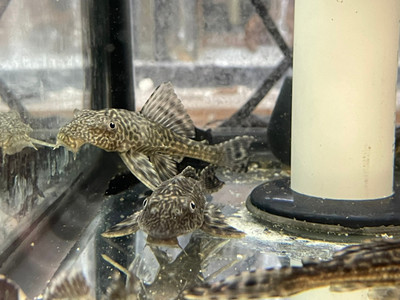Common Pleco (Hypostomus plecostomus)
Posted by Max Gandara on on 27th Nov 2024
Common Pleco (Hypostomus plecostomus) - The Ultimate Guide for Aquarium Keepers
The Common Pleco (Hypostomus plecostomus) is one of the most popular fish species in freshwater aquariums, known for its hardy nature, algae-eating abilities, and unique appearance. With its large, armored body and sucker-like mouth, the Common Pleco is not only a useful addition to your tank for maintaining algae levels but also an intriguing creature to observe. In this blog, we’ll delve into its origin, care tips, and ideal tank mates, ensuring your aquarium thrives with this fascinating fish.
Place of Origin:
The Common Pleco hails from South America, specifically the Amazon and Orinoco river basins. It is found in countries like Brazil, Colombia, and Venezuela, where it inhabits slow-moving waters, including rivers, streams, and flooded areas. These environments provide the Pleco with plenty of hiding spots and submerged surfaces to graze on algae. Its natural habitat consists of murky waters with high oxygen content and an abundance of plant matter.
Appearance and Size:
The Common Pleco is an eye-catching fish, easily recognized by its flattened, armored body, long pectoral fins, and sucker-like mouth. Juvenile Common Plecos can be small and manageable, but they grow rapidly and can reach sizes of up to 24 inches (60 cm) in captivity. This growth means they require ample space in a large aquarium to swim and explore.
Tip: When purchasing a Common Pleco for your aquarium, ensure you have a tank that can accommodate its eventual size to avoid overcrowding and stress.
Tips on Keeping a Common Pleco in an Aquarium:
- Tank Size: Since Common Plecos can grow quite large, they need a spacious tank. A minimum of 75 gallons is recommended for an adult Pleco to provide enough swimming space and comfort. Larger tanks, such as 100 gallons or more, are ideal to prevent the fish from becoming stressed.
- Water Conditions:
- Temperature: Keep the water temperature between 72°F and 86°F (22°C to 30°C).
- pH Level: A pH range of 6.5 to 7.5 is ideal for Common Plecos.
- Hardness: Moderate to hard water is best for this species.
- Filtration: A high-quality filtration system is essential, as Plecos can produce significant waste. A strong filter helps maintain clean water and promotes the health of the fish.
- Substrate: Common Plecos like to scavenge on the bottom of the tank, searching for algae and detritus. Use a smooth substrate, such as fine gravel or sand, to prevent injury to their sensitive underbelly.
- Diet: While Common Plecos are primarily herbivorous and enjoy eating algae, you should supplement their diet with algae wafers, blanched vegetables (such as zucchini, cucumber, and spinach), and sinking pellets. Providing a balanced diet will ensure your Pleco stays healthy and vibrant.
- Hiding Spots: Since they are nocturnal creatures, Common Plecos need plenty of hiding spots to feel secure during the day. Add driftwood, caves, and rocks to your tank to mimic their natural environment and provide shelter.
- Maintenance: Plecos are beneficial for controlling algae in the tank, but they will not eliminate the need for regular tank maintenance. Weekly water changes, filter cleaning, and substrate vacuuming will help keep the aquarium clean and healthy.
Good Tank Mates for the Common Pleco:
Common Plecos are generally peaceful but can become territorial, especially when they feel crowded. It’s essential to choose tank mates that won’t compete too much for space or resources. Here are some good tank mates to consider:
- Cichlids (Non-aggressive species): Larger, peaceful cichlids like angelfish, discus, or rams can coexist with Common Plecos. However, avoid overly aggressive cichlids, as they may bully the Pleco.
- Tetras and Rasboras: Smaller, peaceful schooling fish such as neon tetras, cardinal tetras, and harlequin rasboras can live harmoniously with the Common Pleco without competition for territory.
- Catfish: Other peaceful species of catfish, like Corydoras or Otocinclus, can be excellent companions, as they have different feeding habits and won’t compete with the Pleco for food.
- Guppies and Mollies: These livebearers are also peaceful and can be housed with a Common Pleco. Ensure there’s enough space for all fish to avoid stress.
- Loaches: Fish like the Clown Loach and other peaceful species of loaches can coexist with the Common Pleco, as long as they are not territorial.
Tip: Always monitor your aquarium for signs of aggression or stress. If your Pleco shows any signs of stress, such as hiding constantly or avoiding food, it may not be happy with its tank mates or environment.
Final Thoughts:
The Common Pleco is a hardy, useful, and attractive fish that makes a great addition to a well-maintained, large freshwater aquarium. By providing the right environment, diet, and tank mates, you’ll enjoy watching your Pleco thrive for many years. With proper care, it will continue to keep your tank clean and serve as an excellent companion to your other aquatic life.
Remember, a spacious tank, regular maintenance, and thoughtful consideration of tank mates are key to the health and happiness of your Common Pleco!

